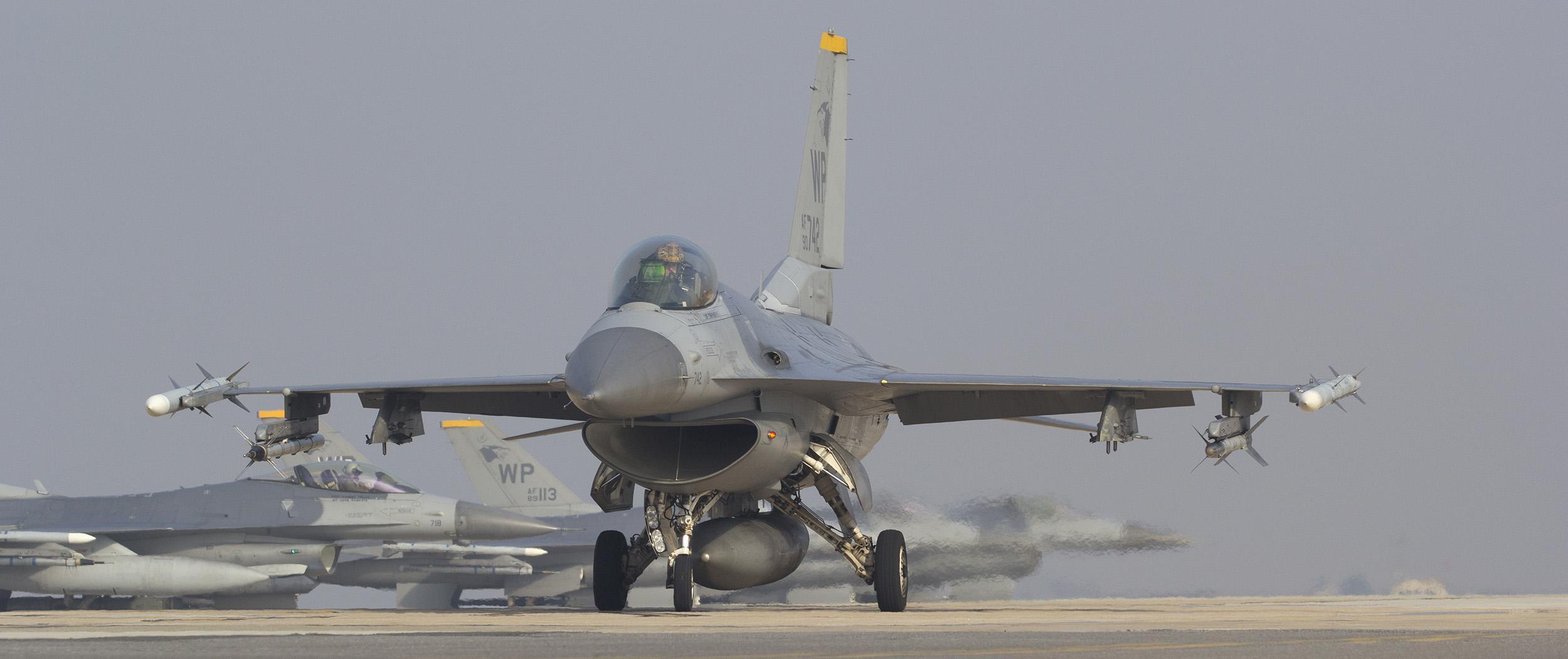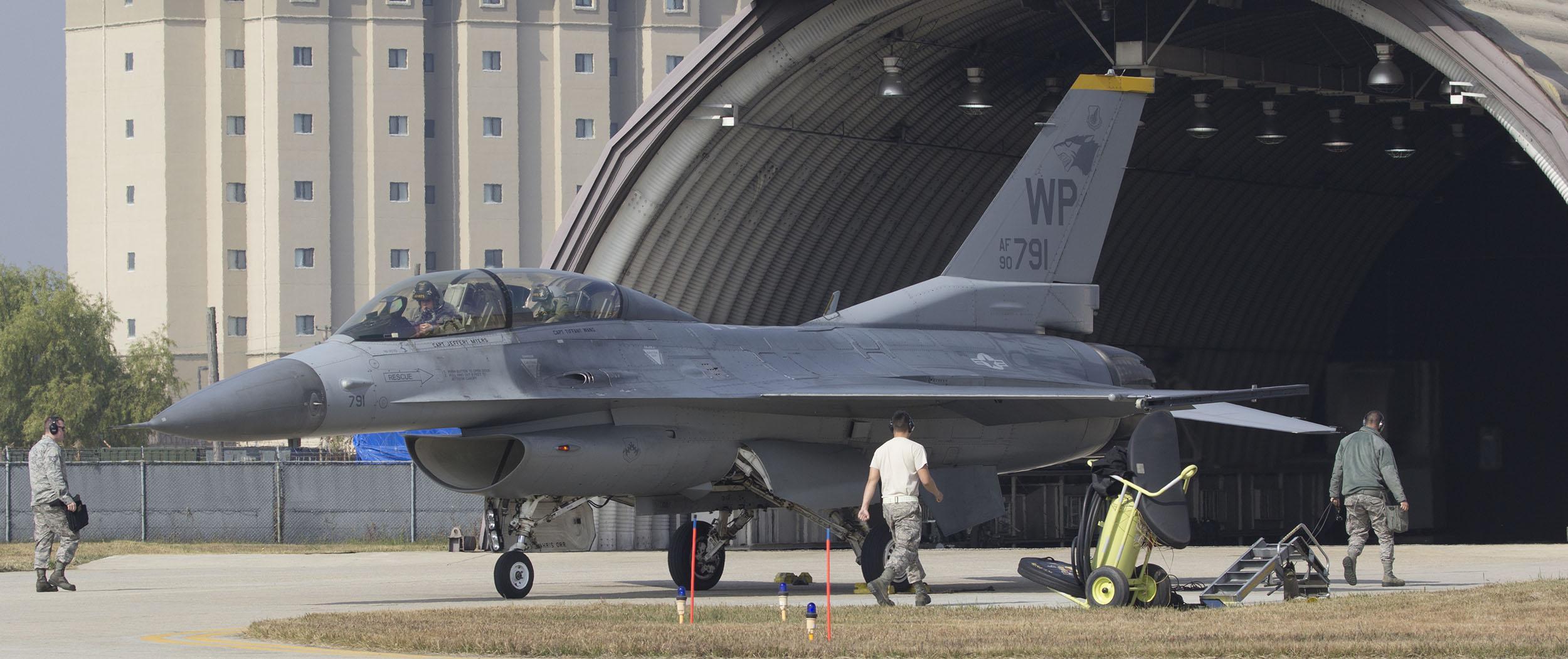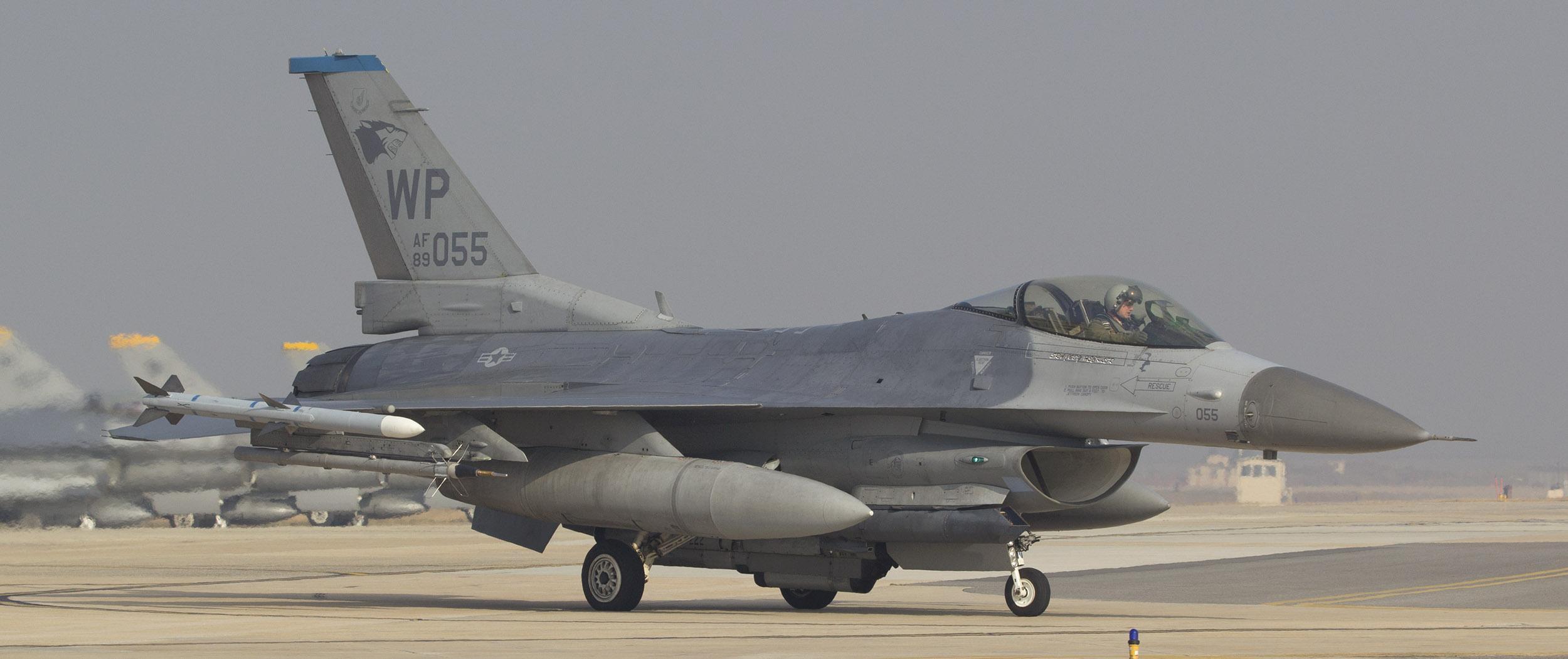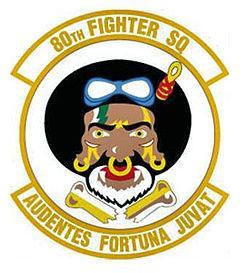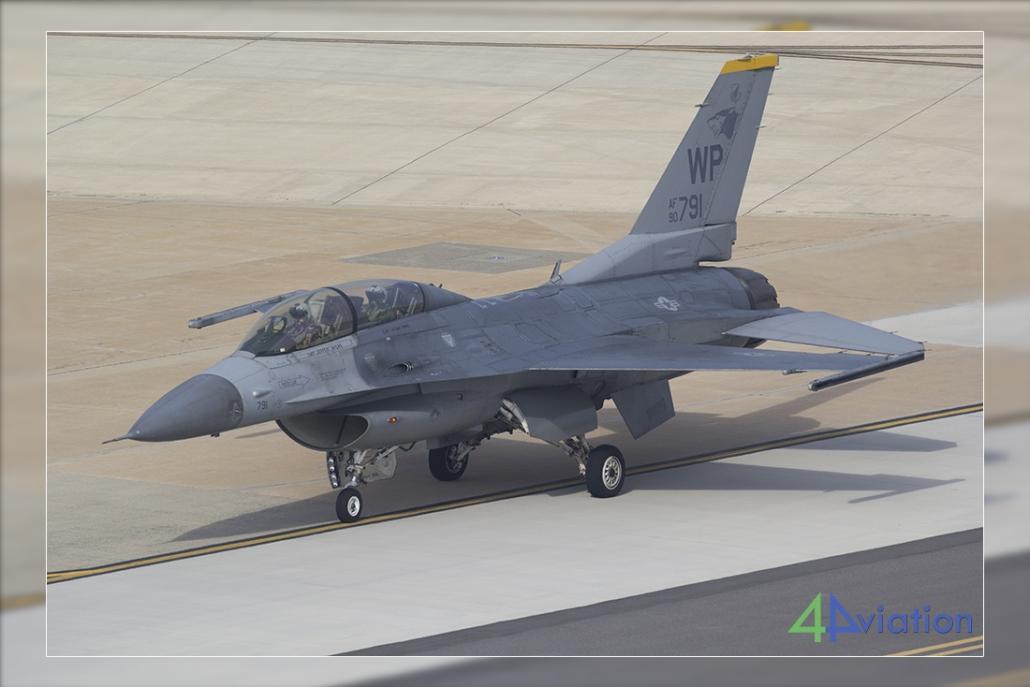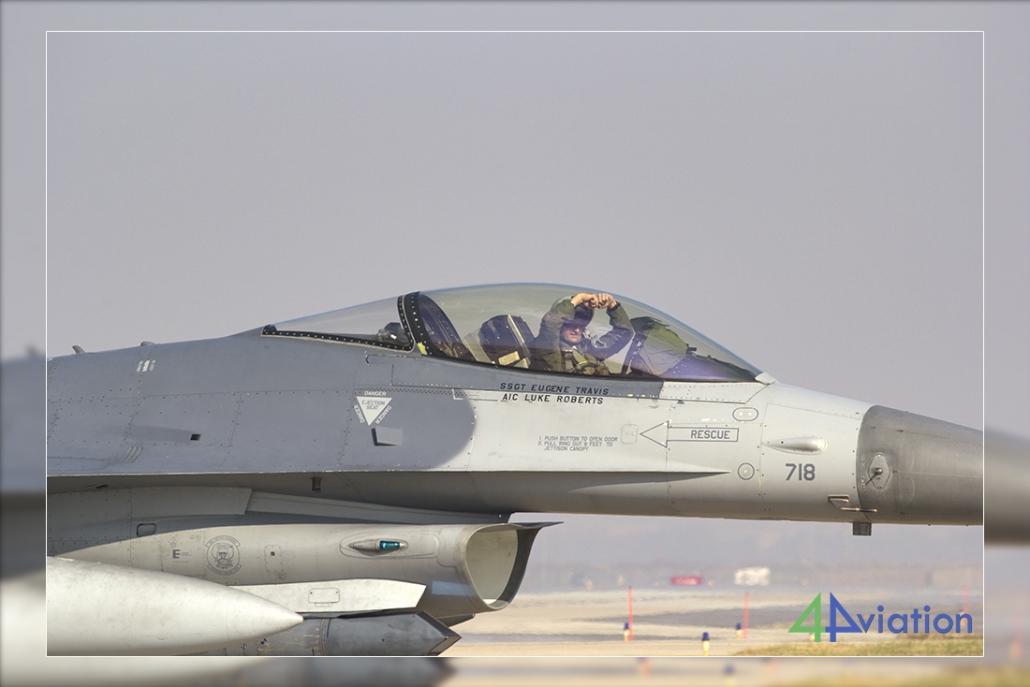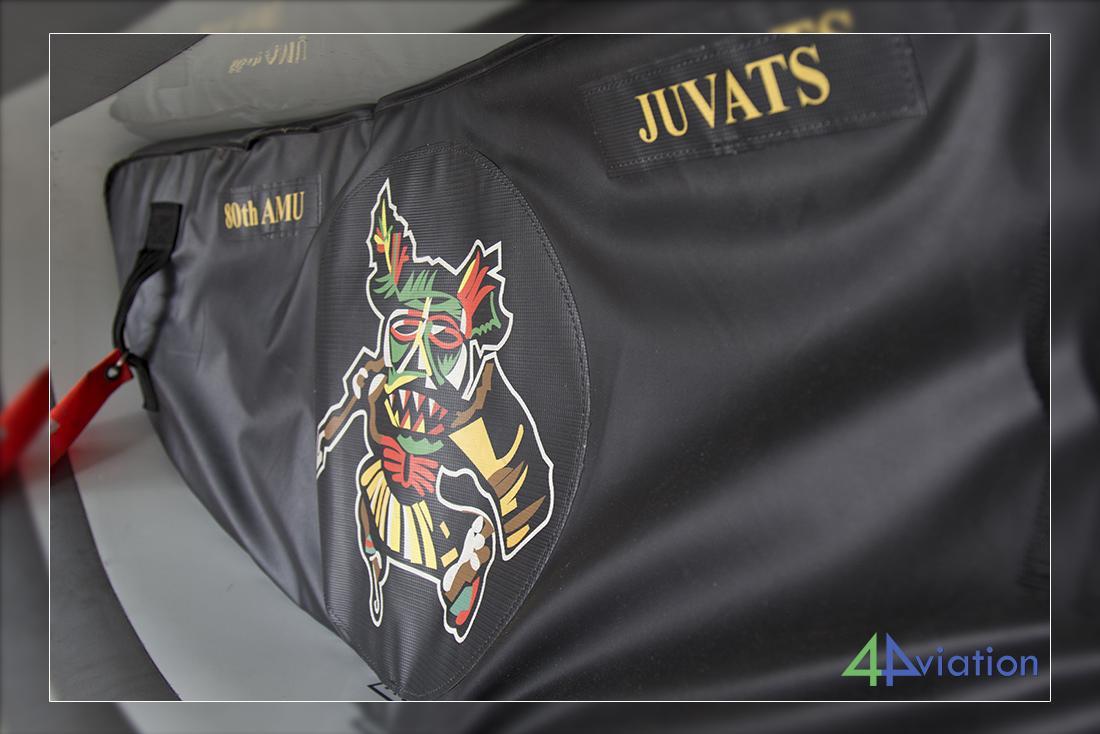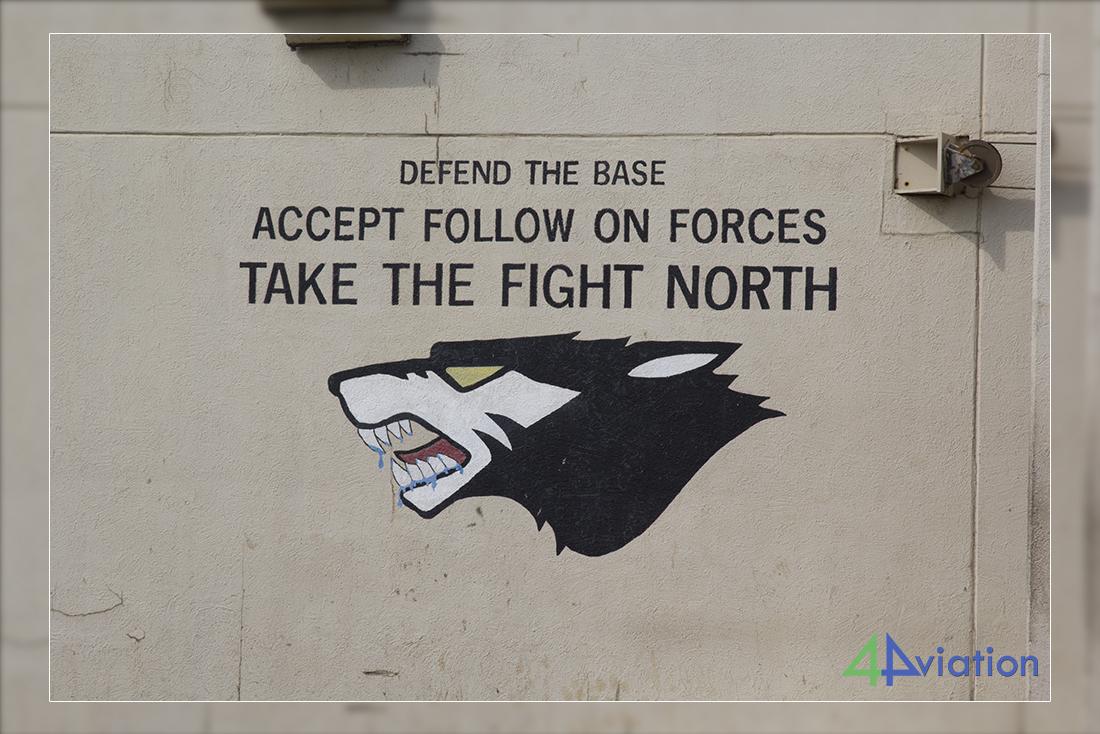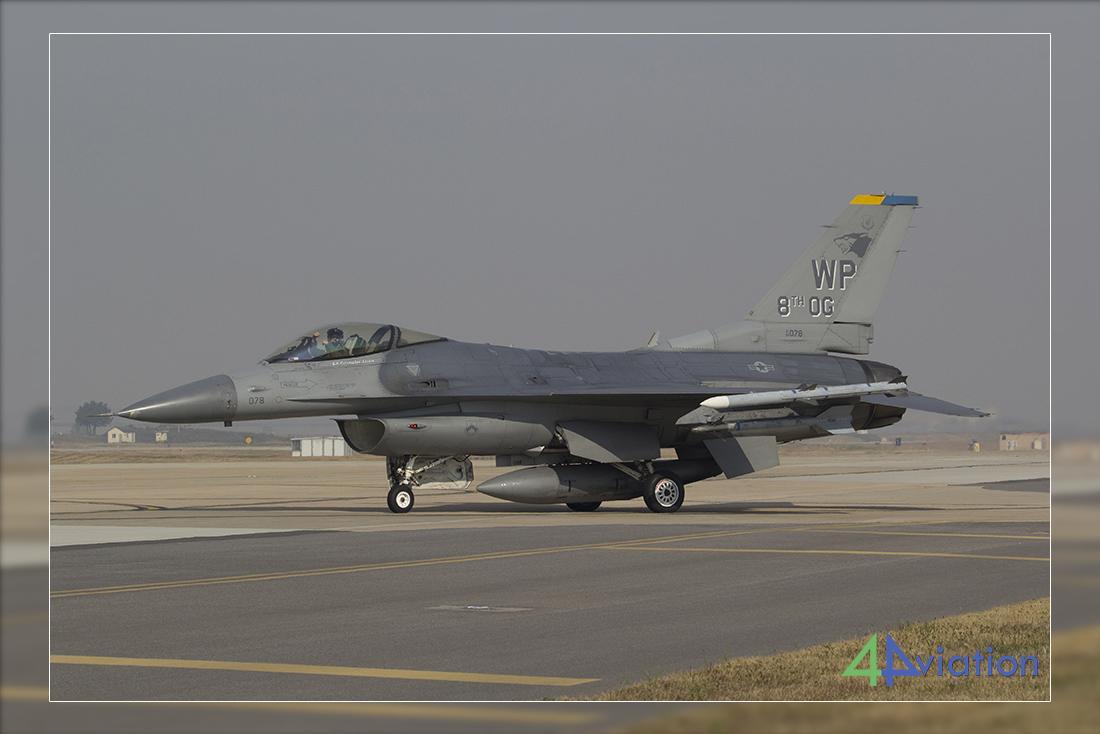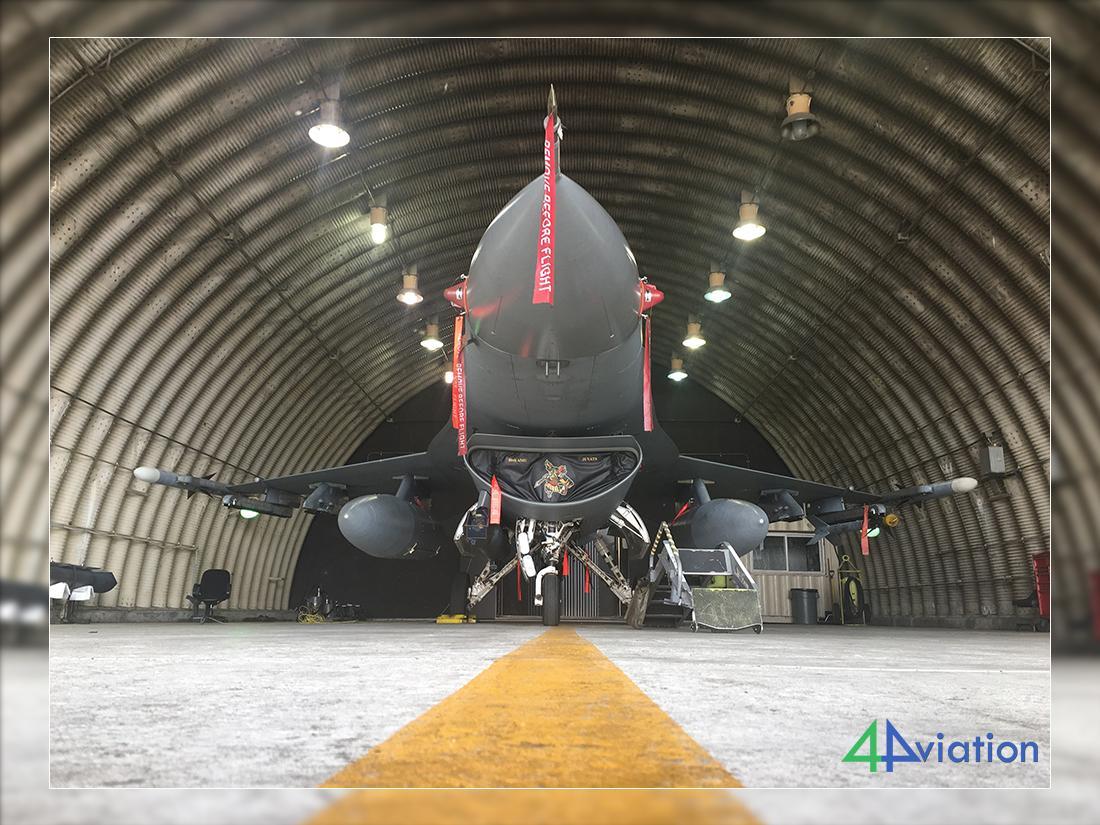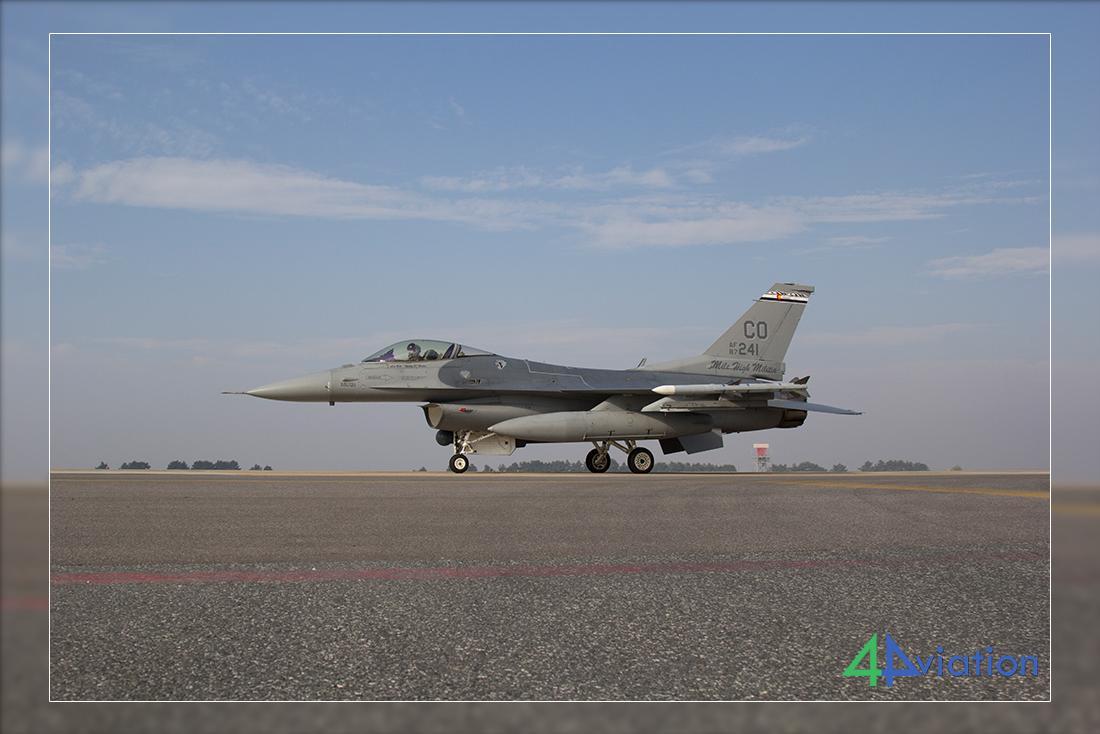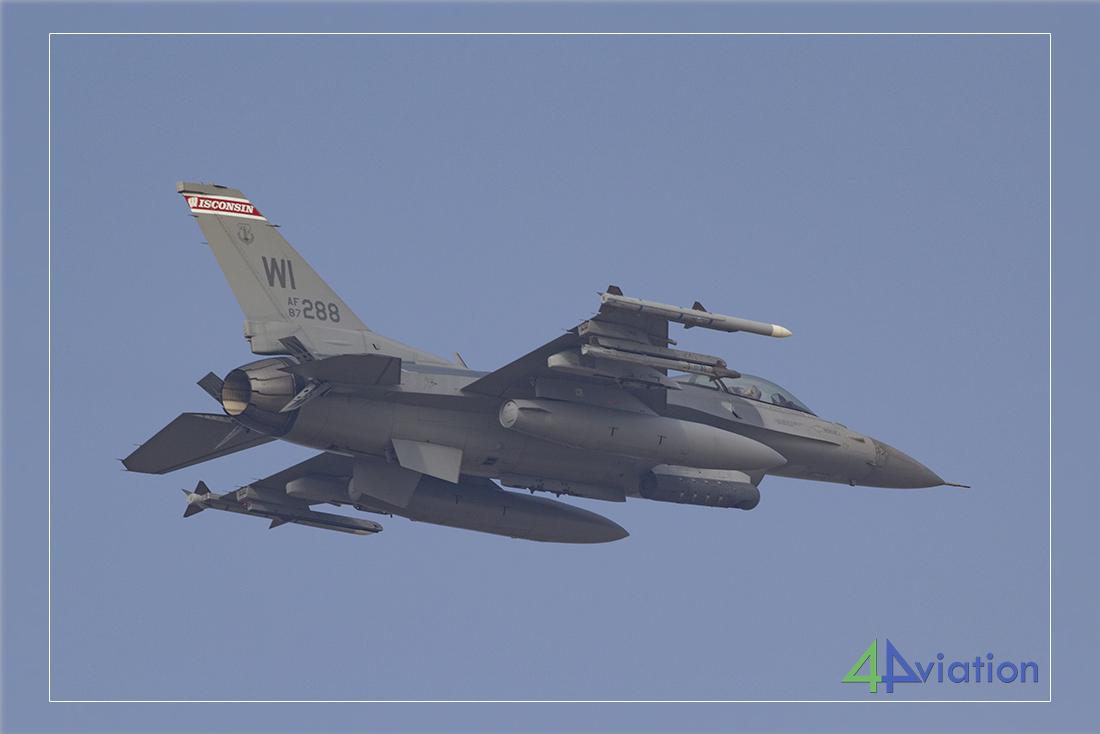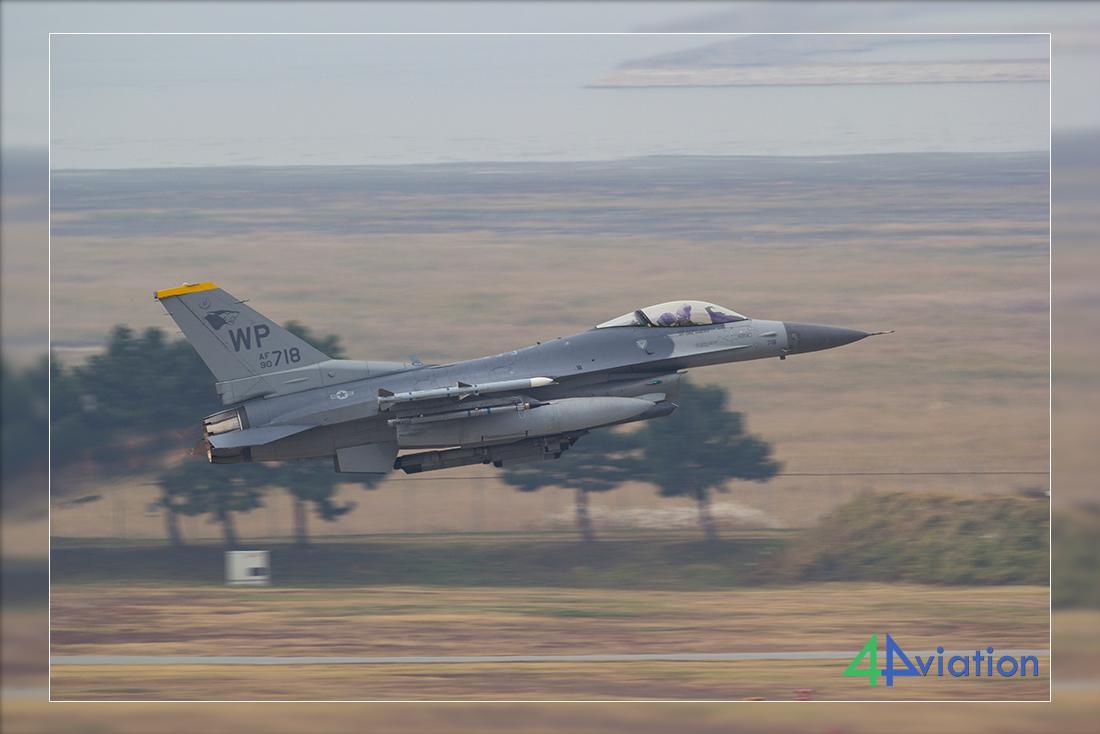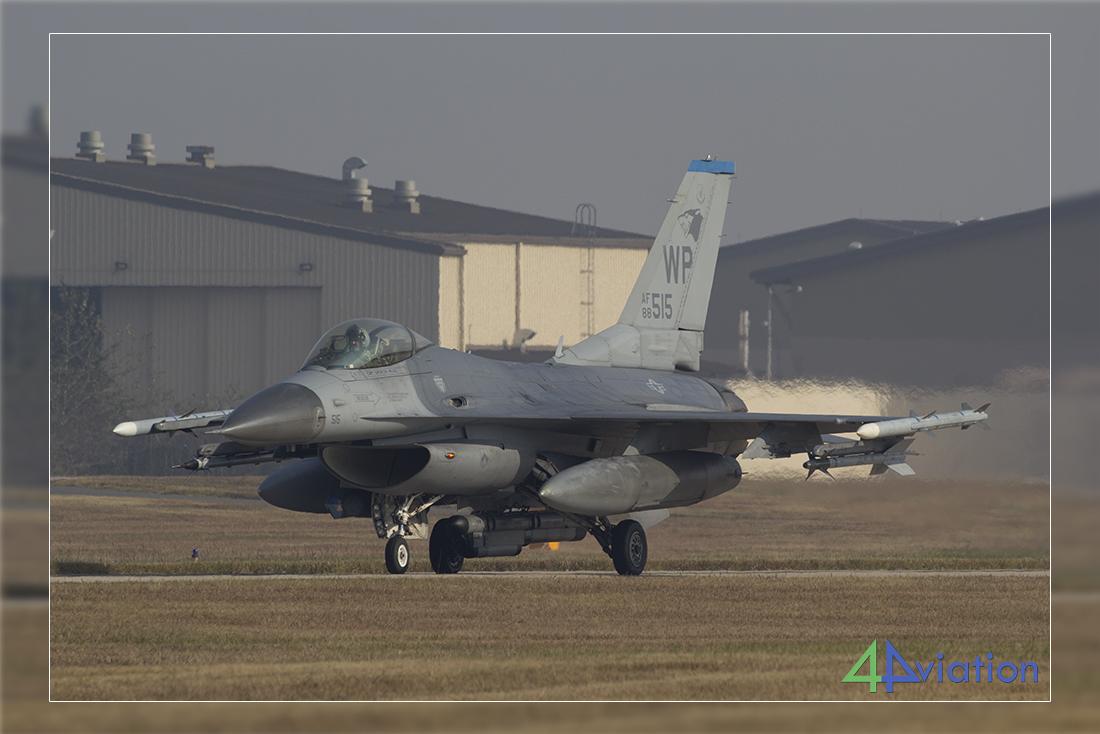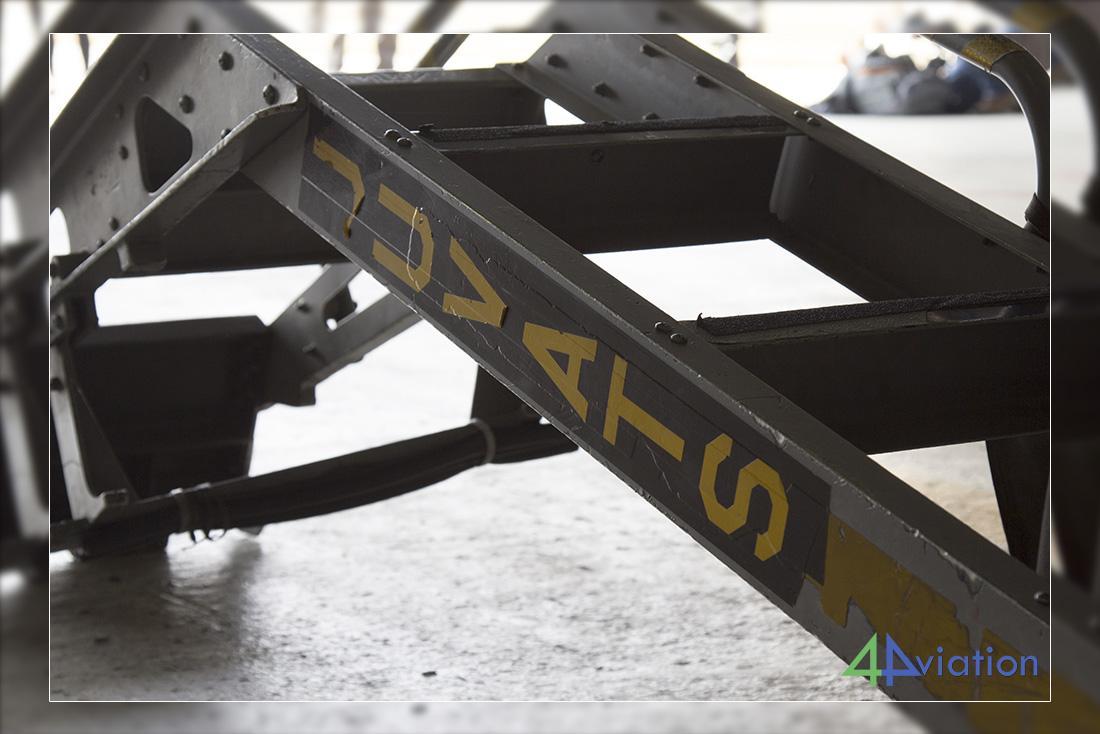80th Fighter Squadron – short history
The 80th Fighter Squadron Juvats flies the F-16CM/DM Block 40 Fighting Falcons out of Kunsan Air Base in the Republic of Korea. It comes under the command of Lt. Col. William D. ‘Lewd’ Lutmer. Together with its sister squadron, 35th Fighter Squadron Pantons, it is assigned to the 8th Operations Group of the 8th Fighter Wing, the Wolf Pack.
The unit stood up during World War II as the 80th Pursuit Squadron (interceptor), on 6 January 1942. After sailing to Australia the unit received its first aircraft, Bell P-39 Airacobras, at Brisbane. Having become part of the 8th Pursuit Group and redesignated 80th Fighter Squadron, the unit flew its first combat missions from Port Moresby, New Guinea, on 22 July 1942 and scored its first aerial victories on 26 August 1942. Early 1943 the unit received the Lockheed P-38 Lightning (replacing their Bell P-400 Airacobras). This aircraft type stayed with the Headhunters until the unit was inactivated at Fukuoka in Japan on 26 December 1945. During WW II the 80th FS was accredited for downing 225 enemy aircraft. No less than 24 Headhunter pilots became aces.
The squadron came to life again at Itazuka AB (Fukuoka), Japan on 20 January 1947, operating the P-51 Mustang. After switching to the Lockheed F-80 Shooting Star in 1950 the 80th was one of the first to see combat in the Korean Conflict and the first American unit to fly jet aircraft in combat. Moving between bases in Japan and Korea the unit remained in continuous combat until the end of the conflict.
While in Japan again after the Korean war the squadron received the F-86F Sabre and F-84G Thunderjet. In 1956 they switched to operating the F-100 Super Sabre, one of the first units to do so. The F-100 was replaced by the Republic F-105 Thunderchief in 1963 before the squadron moved from Itazuke to Yokota Air Base, Japan in May 1964. The Juvats were deployed to Thailand twice for combat in 1964 and 1965. The 80th flew 7,384 combat mission in Southeast Asea, with 2,657 combat missions over North Vietnam.
The F-4C Phantom was introduced in 1967/1968 at Yokota Air Base, where the 80th was then part of the 347th Tactical Fighter Wing. The first F-4C Wild Weasel aircraft arrived in April 1969. On 15 February 1971 the squadron moved to Kunsan Air Base (while being assigned to Det.1 of the 475th TFW at Misawa Air Base, Japan).
At that point the unit began its process of inactivation (transferring crew and aircraft to the 35th TFS, also at Kunsan). This process was halted and the unit saved after former Headhunter Lt. Gen. Jay T. ‘Cock’ Robbins, who was Vice Commander of Tactical Air Command at the time, intervened. The unit was re-staffed with new personnel, mainly from the 391st Tactical Fighter Squadron (also part of 475th TFW and inactivated on 28 February 1971). The 3rd Tactical Fighter Wing became the parent unit on 15 March 1971. This wing was replaced by the 8th TFW on 16 September 1974, reuniting the Headhunters with the Wolf Pack.
In September 1981 the 80th became the first unit stationed overseas to convert to the F-16A/B. From 3 February 1992 the 80th is known as the 80th Fighter Squadron, assigned to the 8th Operations Group (a direct descendant of the 8th Pursuit Group). In 1987 the A/B model F-16s were replaced by C/D Block 30 models. By early 2008 these had been replace by Block 40 versions, which the unit is currently still operating.
Headhunters, Juvats and Conan
When active in New Guinea (Port Moresby) in 1943 one of the first commanders of the unit (Capt Edward ‘Porky’ Cragg) decided to name the squadron Headhunters. The name was meant to remember the New Guinea natives that rescued many P-38 pilots who had been shot down. Many pilots were returned to the Allied lines by sympathetic natives, thus saving them from the Imperial Japanese Army.
The unit badge is also a direct reference and a tribute to the ‘friends down in the jungle’. Blue aviator goggles were added. The green flash refers to the colour used on the tail and the spinners on the P-38s. The broken bone below represents a V, for the 5th Air Force and Victory.
The official squadron motto is Audentes Fortuna Juvat (Latin which is commonly translated into Fortune favours the bold). This motto was ‘illegally’ adopted from the 391st Tactical Fighter Squadron (whose personnel primarily contributed to staffing the 80th TFS early 1971). The motto remained unofficial until approved on 9 October 1986.
On how the nickname Juvats was born, the Official 80th Fighter Squadron Headhunters/Juvats Association website mentions; “The 391st Tactical Fighter Squadron’s insignia was a tiger’s head on an inverted triangular green background. Below the patch, on a rocker, was the 391st motto Audentes Fortuna Juvat […] This motto subsequently became the new Headhunters motto. As the new Headhunters were removing their old 391st patches, they would grasp the triangular patch by the upper left hand corner to tear them off. All would tear off except the word Juvat. It caught on immediately.”
The unit also took inspiration from the movie Conan the Barbarian when it comes to the unofficial motto (What is good?). The quote is derived from the movie quote “What is best in life?” When asked this question, Conan replies “Crush your enemies […]”, while making a gesture with his arms, resembling two snakes facing each other. This “crush’em” gesture is currently used frequently by the airmen in the squadron and acknowledged by the ones the gesture is aimed at.
8th Fighter Wing and Kunsan Air Base
The 8th Fighter Wing is the host unit at Kunsan Air Base. The wing is known as the Wolf Pack, hence the WP code worn by all F-16s of both 8th Operations Group squadrons (35th and 80th). The wings motto; Defend the Base, Accept Follow-On Forces, Take the Fight North.
Originally established as the 8th Fighter Wing on 10 August 1948, the wing saw only a couple of name changes until it was designated 8th Fighter Wing again on 3 February 1992. Being involved in the Korean and Vietnam wars the unit saw various home bases obviously (in Japan, South Korea, North Korea [Pyongyang], the USA and Thailand). From Thailand the wing moved to Kunsan on 16 September 1974. An administrative move only, absorbing all assets of the 3rd TFW at Kunsan. This included the two flying squadrons, the 35th and 80th Tactical Fighter Squadron, reuniting the wing with two of its original squadrons.
The nickname Wolf Pack stems from the time when Col Robin Olds was the wing commander. This was from 30 September 1966 until 23 September 1967, when the wing operated from Udon Air Field in Thailand. Olds is famous for Operation Bolo in 2 January 1967, during which seven VPAF MiG-21s were destroyed.
The wing operates from Kunsan Air Base, located on the West side of South Korea, about 120 miles South of Seoul. Kunsan Air Base was originally built by the Japanese in 1938. The base was in limited US use between 1945 and 1949 and the US Forces left South Korea. In July 1950, soon after the Korean Conflict started, the base was occupied by North Korean forces. It was recaptured again by the US Army on 30 September 1950. From 22 August 1951 the 3rd Bombardment Wing was the first wing assigned to the base (flying B-26 Invaders).
After the Korean Conflict until 1965 the base is mainly used as a temporary host base for units. In 1965 the Republic of Korea Air Force (ROKAF) assigns a squadron to the base flying the F-86 Sabre. Then the only permanently based flying unit for the base. Soon after North Korea captured the USS Pueblo in January 1968, the US started the build up of forces in South Korea and Kunsan saw the 4th Tactical Fighter Wing arriving for its deployment, followed by the 354th TFW, the 54th TFW and the 3rd TFW (which transformed into the current 8th FW Wolf Pack). Today the base employs around 2,700 people (Air Force Members, Army soldiers, US civilians and local national and non-appropriated employees).
The ROKAF calls Kunsan home as well, symbolising the alliance between the US and Korea. The base is home to the ROKAF 38th Fighter Group, operating F-16C/D Block 52 aircraft within the 111th Fighter Squadron.
Col. David G. Shoemaker, the 8th FW, describes the specifics of the base as follows; “The ironclad alliance between the US and Republic of Korea is evident in everything we do. Here at Kunsan Air Base, we train with the 38th Fighter Group of the ROKAF. We enjoy friendships at a personal level while providing for the collective defense of the peninsula and the region. The USAF and ROKAF also work side-by-side in the Air Component headquarters. The saying “Katchi Kapshida” (“We Go Together”), is strong at every level. This is my third yearlong assignment to Kunsan AB in the past 12 years, and the capability of the ROKAF/USAF has improved exponentially in that time. We’ve developed our ability to train and fight together through Red Flags and our Peninsula-wide exercises Max Thunder and Vigilant Ace. Our goal is the same: peace on the peninsula. We hone our craft and ensure our readiness to deter attack. But if called upon to defend our neighbors and allies, may God have mercy on the Wolf Pack’s prey.”
Pantons and Tigers
The second squadron of the Wolf Pack at Kunsan is the 35th Fighter Squadron. The squadron, nicknamed Pantons, also flies the F-16CM/DM Block 40. The unit is one of the oldest USAF squadrons, activated as the 35th Aero Squadron on 12 June 1917. After being demobilised in 1919 the unit was brought to life again in 1932. It moved to the Pacific in 1942 and has stayed in the Pacific area ever since. On 15 March 1972 the unit moved to Kunsan Air Base as part of the 3rd TFW (later 8th).
The third F-16 unit at Kunsan is a ROKAF squadron flying KF-16C/D Block 52 aircraft. The 111st Fighter Squadron is the youngest F-16 unit of the Republic of Korea Air Force, flying the F-16 since 2006. The squadron, nicknamed Tigers, operates its aircraft assigned to the 38th Fighter Group which in itself is subordinate to the 10th Fighter Wing at Suwon Air Base. Being Tigers the pilots make the same tiger paw gestures with their hands as witnessed in Europe during the NATO Tiger Meet. The unit operates alongside its US counterparts. Same base, same runway, but with its own tasking.
Busy Headhunters and busy base
With the threat from the North being ever-present and as real as a threat can get, the base is extremely active and always on a high state of readiness. This means lots of regular training missions, day in day out, and lots of exercises for both the 80th and Kunsan Air Base, while constantly focusing on the wing’s mission; Defend the Base, Accept Follow-On Forces, Take the Fight North.
In 2017 alone, without pretending the list to be complete (the USAF does not provide exercise calendars), the Juvats were involved in;
- Buddy Wing 17-3 (six F-16s to Seosan AB ROKAF between 27 and 31 March 2017)
- Max Thunder 2017 (the second largest flying exercise on the Korean Peninsula, involving 80 aircraft, both USAF and ROKAF, a Red Flag like exercise at Kunsan, between 17 and 28 April 2017)
- Beverly Pack 17-2, (operational readiness exercises, practice the war time mission in a controlled environment, March)
- Red Flag Alaska 17-3 (between 27 July and 11 August 2017)
- Beverly Pack 17-3 (August 2017)
- Buddy Wing 17-6 (Chungju AB ROKAF F-16Cs to Kunsan, September 2017)
- Beverly Pack 18-1 (October 2017)
- Vigilant ACE 2018 (the largest ever joint air exercise between South Korea and the US, involving 230 aircraft, between 4 and 8 December 2017)
In addition to this intensive training and exercise schedule the unit faces the challenges of many personnel being on an unaccompanied tour. This means that the service man and women travel to Korea without their families and many times only serve a one year period on the base. This means; many people coming and leaving, getting to know the base, its specifics and the pace of operations.
Buddy Wing
The alliance between the United States and South Korea is showcased regularly during Buddy Wing exercises. During the week-long exercises USAF and ROKAF exchange ideas, understanding, techniques, knowledge, etc. by operating on each other bases and alongside each other’s aircraft. By training together from mission planning until the end of the flight interoperability and solidarity is enhanced greatly by the Buddy Wing exercises.
Buddy Wing exercises involve 4 to 6 aircraft of USAF deploying to a ROKAF air base and vice versa. The most recent Buddy Wing exercise that 80th Fighter Squadron was involved in was in September 2017. Buddy Wing 17-6 saw ROKAF F-16Cs of the 19th Fighter Wing (Chungju AB) deploying to Kunsan AB for a week of interoperability at its best.
Future
As long as there is no regime change in the North, the Juvats (and the entire Wolf Pack) will most likely be around. Operating from Kunsan and preparing for a conflict that everybody hopes will never happen.
Col. Shoemaker; “Looking into the future, our focus remains unflinchingly on the mission. It does not get much simpler for us here. We know the threat is to the north, and our primary mission statement is to “Take the Fight North.” The Airmen here understand that: the engineers and support Airmen who keep the base running; our maintainers working hard at all hours of the day and night under extreme weather conditions to keep our fighters airworthy and lethal; our fighter pilots who are on their A-game 100 percent of the time… all of our Airmen accomplish these things daily in the face of very real threat a few miles north. In the future, we will remain ready to support combat operations if called upon. This means flying with our Korean partners and exercising to ensure our USAF and ROKAF Airmen have the confidence that we can go to war as an effective fighting force at a moment’s notice. It also means integrating with forces in the region, as we’re seeing now with the incorporation of fifth generation aircraft in Vigilant Ace 17. We’re conducting the same mission, but we’re doing it in a much more focused manner.”
“The 8th Fighter Wing wears its heritage proudly: the famed Wolf Pack of Robin Olds. The Wolf Pack is the most tight-knit, lethal unit in the US Air Force, and the Airmen of the Wolf Pack are extremely skilled at their craft. As diplomatic efforts in the region continue, we take very seriously our responsibility provide our nations’ civilian leadership with military options. I am proud to be these Airmen’s “Wolf”. We fly one of the most capable aircraft in the world with a wide-ranging mission set. The F-16 is a workhorse not only for us, but also for many other nations, to include the ROKAF. Though we are starting to see the integration of 5th generation fighters into our exercises on the Peninsula, the F-16 will hold the line here with our ROKAF friends for many years to come.”
Having these military options available to the US is a must for South Korea, the US and in fact the entire world. Nobody knows how the situation will develop from where it stands now. After their envoy to the DPRK met with the DPRK minister and vice-minister of foreign affairs, the UN recently stated that they agreed that the current situation was the most tense and dangerous peace and security issue in the world today.
Maybe one of the best options suggested recently was in a tweet by Jocko Willink; “Drop 25 million iPhones on them and put satellites over them with free wifi.”

